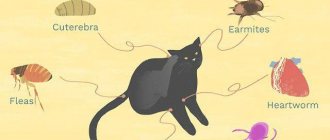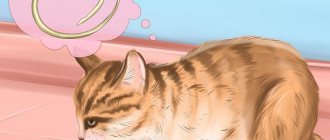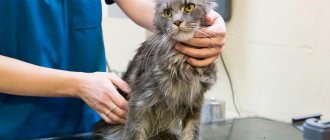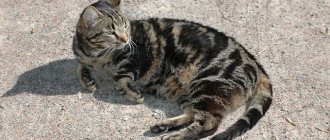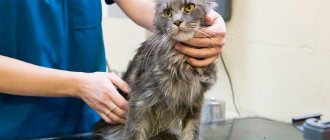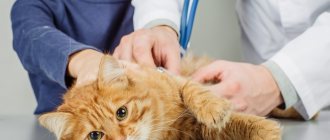What will you learn from the article?
- Where does a cat get worms?
- Symptoms
- Types of worms Tapeworms (cestodes)
- Roundworms (nematodes)
- Flukes (trematodes)
- Medicines for helminths
Helminths (worms in cats) are a very common parasitic disease that can pose a serious threat to the health and life of a pet. From this article you will learn what to do in case of helminthiasis, how to deworm (what anthelmintic drugs to give) and, most importantly, how to prevent your cat from becoming infected with parasites.
Where does a cat get worms?
Worm larvae and adult parasites are found in the environment: in the soil, on the grass, in water bodies. Therefore, it does not mean at all that if your cat is an indoor cat and does not go outside, then he cannot become infected with worms. You yourself can bring the larvae on the soles of your shoes or on your clothes.
Other sources of infection:
- when your cat eats raw fish, meat, or tap water;
- when fleas appear, there is a possibility of your pet becoming infected with worms;
- upon contact with sick animals, contaminated objects (sand, soil) and feces;
- Intrauterine infection of kittens from a pregnant cat is possible.
Suspensions and pastes
These forms of medications are convenient to use, as they can easily be given to kittens and adult animals for worms at home.
| Drug name | Active substance | Spectrum of action | Animal age | Contraindications |
| Prazitel | Pyrantel pamoate + praziquantel | Cestodes and nematodes | From 3 weeks | First half of pregnancy, lactation period |
| Dironet | Pyrantel pamoate + praziquantel + ivermectin | Cestodes, nematodes, larval stage of dirofilariasis | From 3 weeks | Pregnancy and lactation period |
| Dirofen | Praziquantel + pyrantel | Cestodes and nematodes | From 3 weeks | First half of pregnancy, lactation period |
Symptoms
- The presence of fleas is a direct sign of the appearance of worms in a cat.
- Invasive parasites can live not only in the intestines, but also in the bronchi, muscles, and liver, so a number of symptoms may be observed indicating the presence of helminths:
- general exhaustion of the body;
- dull coat;
- lethargic state of the pet;
- refusal of food or, conversely, increased appetite;
- thirst;
- weight loss;
- vomiting and diarrhea (the presence of parasites can be seen in vomit or feces).
- Small rashes around the anus.
- Kittens have swollen bellies, very pale mucous membranes (due to anemia), an upset stomach is replaced by constipation, bloody diarrhea.
The effect of helminths on the cat's body
Worms cause significant damage to a cat's body. They take away nutrients from him, destroying organs and tissues, and poison him with waste products.
Mechanical lesions
Adult helminths cause mechanical damage by attaching themselves to the walls of organs with hooks, suction cups, and cutting blades. They damage tissues, migrating throughout the body from one organ to another, while growing and developing.
After tissue injury, irritation begins, then inflammation and metabolic disorders. The cat’s body does not receive enough nutrients, vitamins, and microelements. In addition, the helminths themselves consume some of these substances. The consequences of prolonged infection are exhaustion, vitamin deficiency, anemia. For example, hookworms gnaw through the intestinal walls and drink blood. One individual drinks 0.3 ml per day. And if in an adult cat the activity of several individuals does not cause manifestations, then worms in a kitten will lead to anemia, even death.
A large population of helminths leads to compression of blood vessels, causing intestinal obstruction or intestinal rupture. The most famous intestinal parasites are roundworms. They do not have a device that can be used to attach to the intestinal walls. Therefore, in order to stay in the digestive organ, roundworms weave into balls. It is these helminths in cats that are a common cause of partial or complete obstruction.
Types of worms
The following types of worms parasitize cats. Each type has its own symptoms and routes of infection.
Tapeworms (cestodes)
Long and flatworms can reach a length of up to 70 cm. The body of these worms consists of many segments, in each of which larvae mature.
When the larvae mature, they separate and come out together with the feces, while the segmented body of the parasite grows continuously, and new segments with larvae appear to replace the separated segments.
Routes of infection
Cats become infected with this type of worms by eating raw meat and fish. Stray animals often become infected with cestodes by eating rats or mice. Infection through larval carriers, fleas, is also possible. Helminths parasitize the walls of the cat's small intestine.
Signs of tapeworm infestation:
- changes in the pet’s body weight (the weight either increases sharply, or the cat, on the contrary, rapidly loses weight);
- change in appetite (the cat is insatiable or, on the contrary, refuses food);
- large, “inflated” belly;
- hair loss;
- Excessive licking in the anal area.
Why are they dangerous?
The cat's gastrointestinal tract becomes clogged with worms, causing intestinal obstruction. Possible death.
As you can see
It is very common to see tapeworm segments around the anus of a sick animal - these segments resemble grains of rice or sesame. Also, individual parts of cestodes are found on the animal’s bedding. In a more severe form of worm infestation, parasites can be seen in the vomit.
Roundworms (nematodes)
The most common type of internal parasites that infect cats. There are many varieties, but the most common in our pets are roundworms. In appearance, the parasites resemble spaghetti, which is where the name “round” comes from. The length of roundworms usually reaches 5 cm, but longer individuals are also found.
Routes of infection
Kittens can become infected with roundworms through their mother's milk. The danger of infection lies in wait for an adult cat when eating rodents, raw meat and in contact with an infected animal.
Signs of roundworm infection:
- weight loss;
- enlarged belly;
- vomit;
- diarrhea;
- general weakness.
Why are they dangerous?
Worms accumulate in the small intestine, injure the gastric mucosa, and can clog the bile ducts and intestines. They can parasitize almost all organs of the animal, having a strong toxic and allergic effect on the body.
As you can see
With intense helminthic infestation, nematodes can be seen in sputum after coughing or in vomit. Roundworm eggs can accumulate in the folds around the animal's anus.
Flukes (trematodes)
Parasites that can be localized anywhere: in the gastrointestinal tract, liver, bile ducts, respiratory organs. These are flatworms with suckers, with which they are firmly attached to the tissues of internal organs, most often the liver. With these suckers, hermaphrodite worms attach to the tissues of the cat's internal organs, eating and destroying them.
Routes of infection
Infection occurs by eating raw fish, seafood or through raw water.
Symptoms of fluke infection:
- cough;
- dyspnea;
- jaundice;
- vomit;
- weight loss;
- diarrhea;
- painful stomach;
- depressed state.
Why are they dangerous?
The activity of parasites disrupts the patency of the bile ducts, causing cirrhosis and liver failure. This can cause lethargy and death.
As you can see
The moving parts of the flukes can come out through the cat's anus. If you look closely, you can see tiny translucent parts of the parasite around the animal's anus, on its bedding.
General information
All cestodes have a rather complex life cycle, which necessarily includes one or more intermediate hosts.
- Of the two main groups of flatworms (cyclophyllidean and pseudophyllidean), cyclophyllideans are more common in cats. In particular, these include the widespread cucumber tapeworm , that is, Dipylidium caninum.
- And also representatives of Taenia, Mesocestoides, as well as representatives of Echinococcus, i.e. echinococci , which pose a serious danger to humans. Why exactly echinococci?
The fact is that both cats, dogs and humans can be either the main hosts, in whose body the adult stage of parasites lives, or intermediate hosts, serving as a “vessel” for the larvae.
And the latter, by the way, have the unpleasant habit of forming blisters filled with scolex (heads) of parasites in the internal organs of the animal . A cat becomes infected when it eats an infected intermediate host. Cestodes grow to adulthood, depending on the type and state of the animal’s immune system, in two to three weeks, but sometimes this period can last up to two to three months.
As in the previous case, pseudophyllidean cestodes, such as Spirometra species or Diphyllobothrium latum, also require intermediate hosts, but one of them must be a freshwater mollusk or other aquatic invertebrate.
Diagnostics
A final diagnosis can only be made by a veterinarian after studying the anamnesis and taking the animal’s feces and blood for analysis. A stool sample is collected for three consecutive days to rule out a “false negative diagnosis.”
If the owner notices particles of worms in the cat’s feces or on the animal’s body, then this should also be reported to the veterinarian.
Important!
Please note that parasite larvae may persist in the milk of nursing cats. Therefore, even if the mother cat has a negative test for worms, it is necessary to carry out thorough anthelmintic therapy for the babies.
Antihelminthics for cats
Anthelmintic drugs are prescribed for medicinal purposes by a veterinarian after all tests have been carried out, the type of parasites, the location and degree of helminthic infestation have been determined.
The doctor must select the brand and form of a targeted drug that acts on a specific type of worm. Or prescribe a medicine with complex action if the cat is infected with several types of helminths or the type of worms could not be determined.
For the purpose of prevention, anthelmintic drugs for cats are prescribed 2-4 times a year. It is mandatory to carry out antiparasitic treatment before mating, before vaccinations and simultaneously with anti-flea drugs.
Medicines for helminths
In veterinary pharmacies, anti-worming drugs for cats with targeted and complex action are widely available in various forms of release:
- Drops on the withers are the most popular products, characterized by quick action and ease of application. The drops are applied to the withers and between the animal's shoulder blades - there is no need to force the cat to drink the bitter medicine.
- Profender (Bayer) - price in Russia for 1 pipette 350-450 rubles / in Ukraine 110-230 UAH);
- Dironet Spot-on (Agrovetzaschita) – price in Russia 350 rubles / in Ukraine 160 UAH.
- Stronghold (Pfizer) – price in Russia 1150 rub. / in Ukraine 550 UAH.
- Anti-worm tablets - given to the animal along with food or “in its pure form”. Preparations with high effectiveness of a complex and targeted (for one type of worm) remedy. Individual selection is possible taking into account the type of parasites, the degree of infestation and the condition of the cat.
- Kanikvantel plus - price in Russia 195 rubles / in Ukraine 70 UAH;
- Enwire - price in Russia 165 rubles / in Ukraine 78 UAH;
- Drontal (Bayer) – price in Russia 320 rubles / in Ukraine 179 UAH;
- Milbemax – price in Russia 330 rubles / in Ukraine 145 UAH;
- Pratel - price in Russia 38 rubles / in Ukraine 6 UAH;
- Trontsil - price in Russia 215 rubles / in Ukraine 15 UAH;
- Febtal – price in Russia 150 rub. / in Ukraine 71 UAH.
- Suspensions or pastes are given to the animal orally using a dispensing syringe. It is convenient to dose and give to cats that refuse to eat tablets.
- Prazicide for adult cats - price in Russia 108 rubles / in Ukraine 45 UAH;
- Prazicide sweet suspension for kittens - price in Russia 127 rubles / in Ukraine 38 UAH.
- Sugar cubes - given to the animal as a treat, with food, or dissolved in water and fed to the animal through a syringe. Animals willingly eat the medicine.
- Polyvercan - price in Russia 605 rub. / in Ukraine 310 UAH.
How to use an anthelmintic drug correctly
- modern drugs for preventive purposes are given once in the morning, a preliminary fasting diet is not required;
- when treating worms in a cat, the drug must be given again after 10-14 days;
- before each vaccination, it is necessary to give antihelminthic drugs 10-15 days before the expected date of vaccination;
- you also need to give antihelminthic drugs 3 weeks before childbirth and 3 weeks after;
How to deworm kittens
- It is not recommended to give anthelmintic drugs to kittens younger than 8 weeks;
- kittens are dewormed for the first time at the age of 2 months, when the body is stronger and can perceive the toxic substances of anthelmintic drugs;
- the drug is chosen on the recommendation of a veterinarian, the dosage is calculated based on the age and weight of the kitten;
- repeat the procedure 10-14 days after the first dose.
Folk remedies
Traditional medicine for worms in cats does not have proven effectiveness and is presented in the article for informational purposes.
- Give a decoction of chamomile or fennel to drink instead of water.
- Cut the onions into 4 parts and pour a glass of warm boiled water. Give your cat this water to drink in the morning on an empty stomach for 7 days.
- Common tansy. Pour 1 tablespoon of flowers with a glass of boiling water and leave for 1 hour, then strain. Give the cat this infusion 2-3 times a day, then feed it no earlier than 30-60 minutes later.
- Alcohol tincture of wormwood is used 10 drops 2 times a day. Feed the cat no earlier than every 30-60 minutes.
- Carrot juice enemas (20 ml) once a day for a week.
Rules for deworming
In order for deworming for cats and kittens to be not only effective, but also safe, you need to adhere to certain rules.
- Before ridding a cat of worms, it is necessary to carry out treatment against feline ectoparasites, which are carriers of many intestinal invasions.
- Choose the right drug. For prevention, it is better to use a complex product that simultaneously destroys cestodes and nematodes.
- In order to calculate the dosage, you should find out the exact weight of the animal. Kittens should be weighed before each preventive or therapeutic treatment for worms.
- Select anthelmintic drugs according to the age of the animal. Most manufacturers produce special low-toxic lines of medications for kittens.
- Before using medications, you should carefully read the instructions, study possible side effects and contraindications.
- Anthelmintic medications intended for humans, dogs or other animals should not be administered to cats.
- 4-5 hours after feeding the drug, the animal should be given a sorbent (activated carbon).
In the first hours after using the medicine, you need to watch the toilet. If there is no natural bowel movement, you can use mild laxative syrups such as Lactusan or Duphalac in a dosage of 5-7 ml.
Note! If a cat suffers from an infectious disease, then the use of anthelmintic drugs during this period can sharply worsen the animal’s condition and even lead to death.
Prevention
The disease is easier to prevent than to treat, and therefore, to minimize the risk of your cat getting worms, do the following:
- Preventive use of antiparasitic drugs for fleas, ticks, and worms once every 3 months. First we use anti-flea products, after 3 days - against worms.
- Do not feed the animal raw meat, drink only boiled/settled water.
- Avoid contact with street animals.
- Regularly carry out antiparasitic treatment of the cat's place and scratching posts. Keep your cat's grooming supplies clean.
- Clean your house/apartment regularly and take off your shoes in the hallway.
Important!
Remember that most of the helminths that infect cats are also dangerous for humans, so if your pet is found to have parasites, worry about your health too.
Owner stories
Sofia: “We adopted a cat from a shelter. It turned out that the cat had worms. Moreover, there were a lot of them, all the feces were strewn with larvae and parts of parasites, such small white things. We suffered with her until the veterinarian advised us this treatment regimen: Kanikquantel suspension three times with an interval of 2 weeks. We're doing well now."
Tamara: “My son brought a kitten from the street. I immediately realized that the cat had worms - the baby’s tummy looked like an inflated balloon. Poor thing, he suffered while he was a wanderer. The veterinarian said to give Prasitab tablets. One tablet is designed for an animal weighing 4 kg. I gave a little less than half, crushed it into powder and diluted it with water. This mixture was poured into the baby using a syringe without a needle.”

